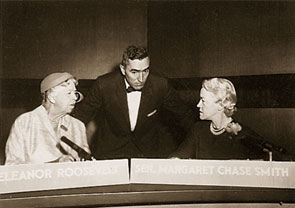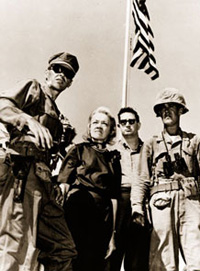Onto the National Stage
Congresswomen in an Age of Crises, 1935–1954
Crafting an Identity
 Former First Lady Eleanor Roosevelt (left) and Senator Margaret Chase Smith of Maine on the set of the political television program Face the Nation in Washington, D.C., on November 11, 1956. Both women were leading figures in the Democratic and Republican parties, respectively.Image courtesy of the FDR Library/National Archives and Records Administration
Former First Lady Eleanor Roosevelt (left) and Senator Margaret Chase Smith of Maine on the set of the political television program Face the Nation in Washington, D.C., on November 11, 1956. Both women were leading figures in the Democratic and Republican parties, respectively.Image courtesy of the FDR Library/National Archives and Records AdministrationSecond-generation women in Congress legislated sporadically on issues of special importance to their gender and on the initiative of individuals rather than that of a group. The paucity of Congresswomen inhibited the development of a coherent women’s-issues agenda until the 1970s. Few embraced a “feminist” agenda —preferring to work within the prescribed institutional channels.
There were exceptions, however. Congresswoman Winifred Stanley introduced the first equal-pay legislation in Congress, arguing that women and men should receive the same compensation for the same type of work. “Merit, regardless of sex, should be the basis of employment,” Stanley said. “Jobs should be filled by those best qualified by ability, training and experience, with the consideration given to men and women of the armed services.”31 Unsuccessful equal pay measures were introduced repeatedly in the decades that followed, notably by Representative Kelly in 1951 and by Representative Cecil Harden of Indiana in 1957. Stanley, along with then-Representative Margaret Chase Smith, also renewed the drive for the passage of the Equal Rights Amendment in 1943 to mark the 20th anniversary of its introduction to Congress.
House veteran Mary Norton realized that there were not enough women in Congress to support such an agenda. In the months immediately following the war, she despaired that a quarter century after earning the vote, women had failed to organize as an effective political bloc. “We won’t see a dozen women in Congress in our day because women won’t vote for women,” Norton lamented.32 More than a dozen women did serve in the 83rd Congress, two years after Norton retired. But women did not consistently hold even two dozen seats in Congress (about 5 percent of the total membership) until the mid-1980s.
Chase Woodhouse, one of Norton’s contemporaries, recalled that she and her women colleagues in the House earnestly pursued individual projects but did not reach a consensus on legislation about issues that were particularly relevant to women, namely, education, employment, childcare, reproductive rights, and health issues. Norton, Woodhouse observed, worked hard to minimize distinctions between women and men in everyday House activities, insisting that the men treat the women as “Congressmen”; there were no “ladies first” in the line for the elevator, and women Members would wear plain business suits and no “frillies” or hats on the House Floor. “None of us were women’s women,” Woodhouse recalled years later of colleagues like Emily Douglas, Helen Douglas, Sumner, and Luce.33 Woodhouse secured federal money for programs and organizations that were important to women, particularly prenatal clinics and child welfare agencies.34 Acutely concerned with helping women in the workplace, Woodhouse nevertheless distanced herself from vocal feminists. “I always say I never attack a brick wall,” she observed years later. “I try to go around it, and the people who are defending the other side are so surprised to see me that they even say, ‘How do you do? What can I do for you?’”35 Her colleague Frances Bolton chafed at the term “Congresswoman.” “It doesn’t exist” in the dictionary, she once snapped. “We’ve had Congressmen here for a good many generations. But we’ve never had Congresswomen. You’re a woman Congressman. It’s just like a chairman. Some people say chairwoman. But that’s just silly.”36
Importantly, however, a new legislative style for women in Congress was being pioneered by celebrities-turned-politicians—a “show horse,” or publicity-driven style.37 Capitalizing on their fame, Luce and Helen Douglas chose to become partisan champions of the issue du jour rather than to specialize in areas of legislative interest. Congresswoman Luce, a glamorous playwright, delivered the keynote address at the 1944 GOP National Convention; it was the first time a woman was accorded this honor by a major party.38 Several weeks later, Douglas, an actress and a singer and the wife of film star Melvyn Douglas—then making her first run for the House—was featured prominently at the Democratic National Convention.39 The energy these women derived from the intense media coverage of their House careers became part of their style. Reflecting late in life on her move to a career in politics, Douglas remarked, “I never felt I left the stage.”40 While neither Luce nor Douglas used this legislative style to advance a “women’s-issues” agenda, later generations of women in Congress adopted their style to become public advocates for feminist concerns, particularly Bella Abzug of New York and, to a lesser degree, Martha Griffiths of Michigan and Patricia Schroeder of Colorado. In the late 1940s, California Congressman Jerry Voorhis marveled at the precarious balancing act of his women colleagues, who charted “a course midway between two fatal mistakes.” Voorhis observed that “the woman member must take care that she does not base her appeal for the cause in which she is interested on the fact of her womanhood. She cannot expect chivalry from the male members when it comes to casting their votes. Neither, on the other hand, can she hope to gain a strong position for herself if she attempts the role of a hail fellow well met and tries to be like the men. What she has to do is to be simply a member of the House who quite incidentally happens to belong to the female sex.”41
Institutional and cultural barriers added to the precariousness of women’s new foothold in national political life. The Cold War, enduring paternalistic social patterns, and the temporary decline of feminist reform blunted women’s drive for political power, leaving the third generation of Congresswomen—those elected from the 1950s to the early 1970s to begin fundamentally altering the legislative landscape.
Footnotes
- “Miss Stanley Backs Bill and Plank on Equal Pay,” 20 June 1944, New York Times: 22.
- Quoted in Norton’s obituary in the 1959 Current Biography.
- Chase Going Woodhouse, oral history interview with Joyce Pendry, 31 January 1981, Center for Oral History and Women’s Study Programs, University of Connecticut, Storrs: 63–69.
- “Chase Going Woodhouse,” Current Biography, 1945 (New York: H. W. Wilson and Company, 1945): 690-692.; see also on the housing issues, Congressional Record, House, 79th Cong., 2nd sess. (28 June 1946): 7894–7897; on the OPA and price controls see, Congressional Record, House, 79th Cong., 2nd sess. (16 April 1946): 3798–3800; Congressional Record, House 79th Cong., 2nd sess. (17 April 1946): 3892–3893.
- Chase Going Woodhouse, Oral History Interview, USAFMOC: 31.
- Peggy Lampson, Few Are Chosen: American Women in Political Life Today (Boston: Houghton Mifflin Company, 1968): 33.
- For more on the differences between the “work horse” and the “show horse” styles, see Donald R. Matthews, “The Folkways of the United States Senate: Conformity to Group Norms and Legislative Effectiveness,” American Political Science Review 53 (December 1959): 1064–1089. The same pattern has been observed in the House; see Charles L. Clapp, The Congressman: His Work As He Sees It (Garden City, NY: Doubleday, 1964): 22–23. See also James L. Payne, “Show Horses and Work Horses in the United States House of Representatives,” Polity 12 (Spring 1980): 428–456.
- Kathleen McLaughlin, “Mrs. Luce Assails ‘Bumbledom’ Trend,” 28 June 1944, New York Times: 15.
- “‘Fencing’ with Mrs. Luce Barred by Miss Gahagan,” 16 July 1944, New York Times: 26; “Republican ‘Double Talk’ Assailed by Mrs. Douglas,” 21 July 1944, Christian Science Monitor: 14; “Roosevelt Needed, Mrs. Douglas Says,” 21 July 1944, New York Times: 11.
- Ingrid Winther Scobie, Center Stage: Helen Douglas, A Life (New Brunswick, NJ: Rutgers University Press, 1995): 306.
- Jerry Voorhis, Confessions of a Congressman (Garden City, NY: Doubleday & Company, 1947): 35.

